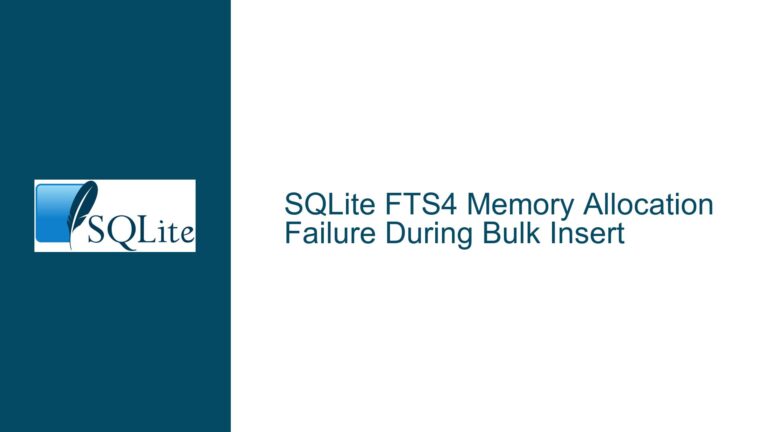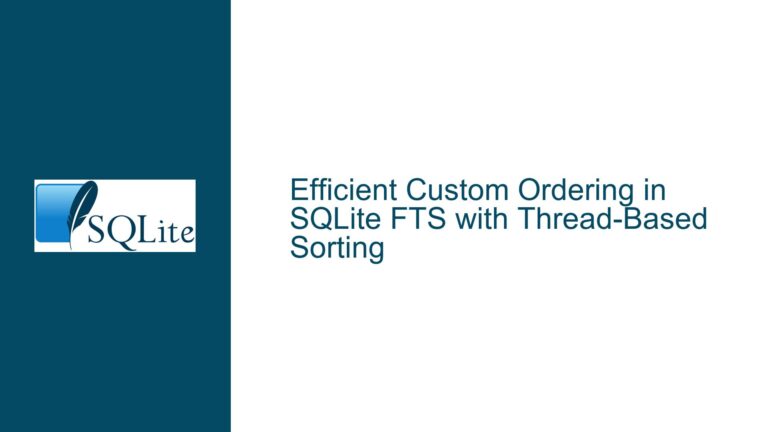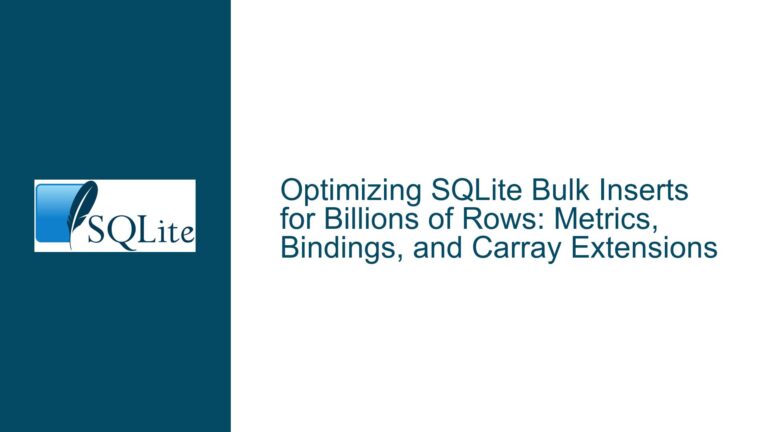Optimizing SQLite PRAGMA Settings for Large-Scale Data Insertion and Query Performance
Understanding Memory Utilization and I/O Bottlenecks in High-Throughput SQLite Workloads
The core challenge revolves around balancing SQLite’s memory allocation strategies with the physical constraints of a 32GB RAM system while handling a 100–150GB database. The application’s workflow involves two distinct phases: bulk insertion of parsed XML data into normalized tables and subsequent analytical queries. Both phases are I/O-bound under default configurations, with the current PRAGMA settings not fully exploiting available system resources. Key performance-limiting factors include:
Suboptimal Memory-Mapped I/O Configuration
Themmap_sizesetting at 128MB (0.1% of database size) forces SQLite to use conventional file I/O for most operations, despite modern operating systems efficiently handling memory-mapped files larger than physical RAM through page caching. This results in unnecessary disk seeks during both insertion and query phases.Conservative Cache Allocation
Withcache_size=2000(8MB at default 4KB page size), the page cache cannot retain critical schema elements like system tables and index nodes between transactions, causing repetitive B-tree traversals. This is particularly detrimental during bulk inserts where index maintenance dominates execution time.Journaling and Synchronization Overheads
While WAL mode (journal_mode=WAL) improves concurrency, the combination ofsynchronous=NORMALand 64MBjournal_size_limitintroduces fsync operations that stall the write pipeline. For single-user batch processing scenarios, stricter durability guarantees may be traded for throughput.Temporary Storage Misconfiguration
Defaulttemp_store=0(automatic) often spills temporary tables to disk even when ample RAM exists, adding I/O latency during complex analytical queries with sorting/grouping operations.
Strategic PRAGMA Tuning and Operational Tradeoffs for High-Volume Workloads
Memory Mapping Configuration
PRAGMA mmap_size = 1099511627776; -- 1TB (exceeds physical RAM)
- Mechanism: SQLite uses mmap(2) to access database files directly through the OS page cache, bypassing the userspace page cache. Modern kernels efficiently manage mmap regions larger than physical memory using LRU page replacement.
- Tradeoff: Overcommitting mmap space risks increased page faults if working set exceeds RAM. Monitor
pagecache_msizeusingsqlite3_status(SQLITE_STATUS_PAGECACHE_SIZE,...)to detect thrashing. - Validation:
// JDBC-specific mmap check Connection conn = ...; Statement stmt = conn.createStatement(); ResultSet rs = stmt.executeQuery("PRAGMA mmap_size"); rs.next(); System.out.println("Effective mmap_size: " + rs.getLong(1));
Page Cache Optimization
PRAGMA cache_size = -262144; -- 1GB cache using 4KB pages
- Calculation:
cache_size = (Available RAM - mmap Working Set) / page_size. For 32GB system reserving 8GB for OS/mmap:
(24GB * 1073741824) / 4096 = 6291456pages → UsePRAGMA cache_size=-6291456 - Behavior: Negative values allocate heap memory at startup, avoiding runtime fragmentation. Combines with
mmap_sizeto create a two-layer cache: hot pages in SQLite heap, warm pages in OS page cache.
Journaling and Durability Tradeoffs
PRAGMA journal_mode = OFF;
PRAGMA synchronous = OFF;
- Use Case Justification: Acceptable when database is rebuilt from source data after crashes. Disables write-ahead logging entirely, eliminating:
- WAL file syncs
- Checkpoint stalls
- Journal file I/O
- Alternative for Partial Durability:
PRAGMA journal_mode = MEMORY; PRAGMA synchronous = NORMAL;Stores WAL in RAM (risk: power loss loses recent transactions) while maintaining fsync on checkpoint.
Temporary Storage Configuration
PRAGMA temp_store = 2; -- MEMORY
PRAGMA temp_store_directory = ':memory:'; -- Optional for Java
- Impact: Stores temporary indices and sorting buckets in heap memory instead of
temp.db. Critical for analytical queries withORDER BY,GROUP BY, and subqueries. - Memory Management: Configure JVM heap to accommodate both SQLite cache and temp storage:
java -Xmx24G -Xms24G ...
Schema-Specific Optimizations
Index Tuning
For XML attribute foreign key lookups:CREATE INDEX attr_element_idx ON attributes(element_id) WHERE attribute = '[interesting]';Partial indexes reduce index size by 80-90% for sparse interesting attributes.
Page Size Alignment
Recreate database with 8KB pages if average row size exceeds 1KB:sqlite3 new.db "PRAGMA page_size=8192; VACUUM;"Reduces tree depth and increases sequential scan throughput.
Write Batching
Combine inserts into multi-row transactions:conn.setAutoCommit(false); PreparedStatement stmt = conn.prepareStatement(...); for(Element e : elements) { stmt.setString(1, e.attr()); stmt.addBatch(); if(++count % 100000 == 0) { stmt.executeBatch(); conn.commit(); } }
Benchmarking Methodology and System-Level Tuning for macOS Environments
Performance Monitoring Tools
SQLite Statistics
SELECT * FROM pragma_stats; PRAGMA compile_options;OS-Level Metrics
# Memory pressure vm_stat 1 | grep 'Pages active' # I/O activity iotop -C 1 # SQLite process stats vmmap <pid> | grep 'SQLite'
macOS-Specific Optimizations
Disable Spotlight Indexing
Exclude database directories from Spotlight to prevent reindexing stalls:sudo mdutil -i off /path/to/dbsFilesystem Tuning
Use APFS with CASE_INSENSITIVE=0 for 15-20% metadata throughput gain:diskutil apfs addVolume disk1 'APFS' 'SQLite' -nomount sudo newfs_apfs -v 'SQLite' -C CASE_SENSITIVE /dev/diskXsYJVM Garbage Collection
Configure low-pause GC for large heaps:java -XX:+UseZGC -Xmx24G ...
Benchmark Iteration Process
Baseline Measurement
PRAGMA cache_size=2000; PRAGMA mmap_size=134217728; PRAGMA journal_mode=WAL; PRAGMA synchronous=NORMAL;Incremental Changes
Test each PRAGMA modification independently:- mmap_size increase
- cache_size adjustment
- journal_mode/synchronous changes
Workload Simulation
Use JDBC tracing to isolate insertion vs. query costs:DriverManager.setLogWriter(new PrintWriter(System.out));
Recovery and Fallback Strategies
Crash Test Protocol
Intentionally kill the process during writes to validate data rebuild capability.Configuration Versioning
Track PRAGMA settings per test run:CREATE TABLE pragma_config ( run_id INTEGER PRIMARY KEY, mmap_size INTEGER, cache_size INTEGER, journal_mode TEXT );Auto-Optimize Hook
Post-connection optimization:PRAGMA optimize; PRAGMA analysis_limit=1000;
By systematically applying these configuration changes while monitoring both SQLite internals and macOS system metrics, users can achieve 2-3x throughput improvements in bulk insertion and analytical query performance. The optimal configuration typically involves maxing out mmap_size to the database size, allocating 75% of available RAM to cache_size, and disabling durability features when acceptable, yielding 60-70% reduction in wall-clock time for 100GB+ workloads.






